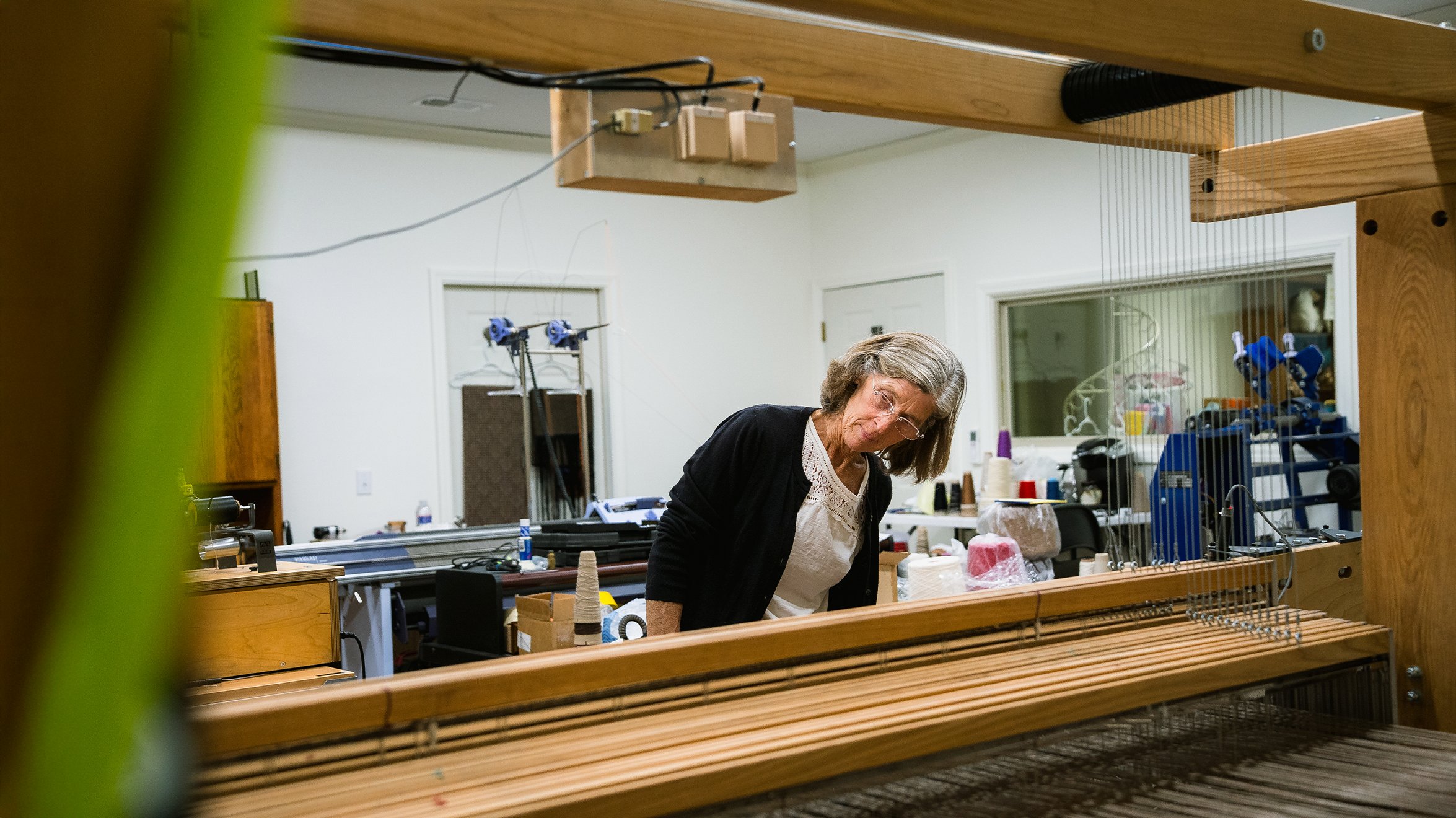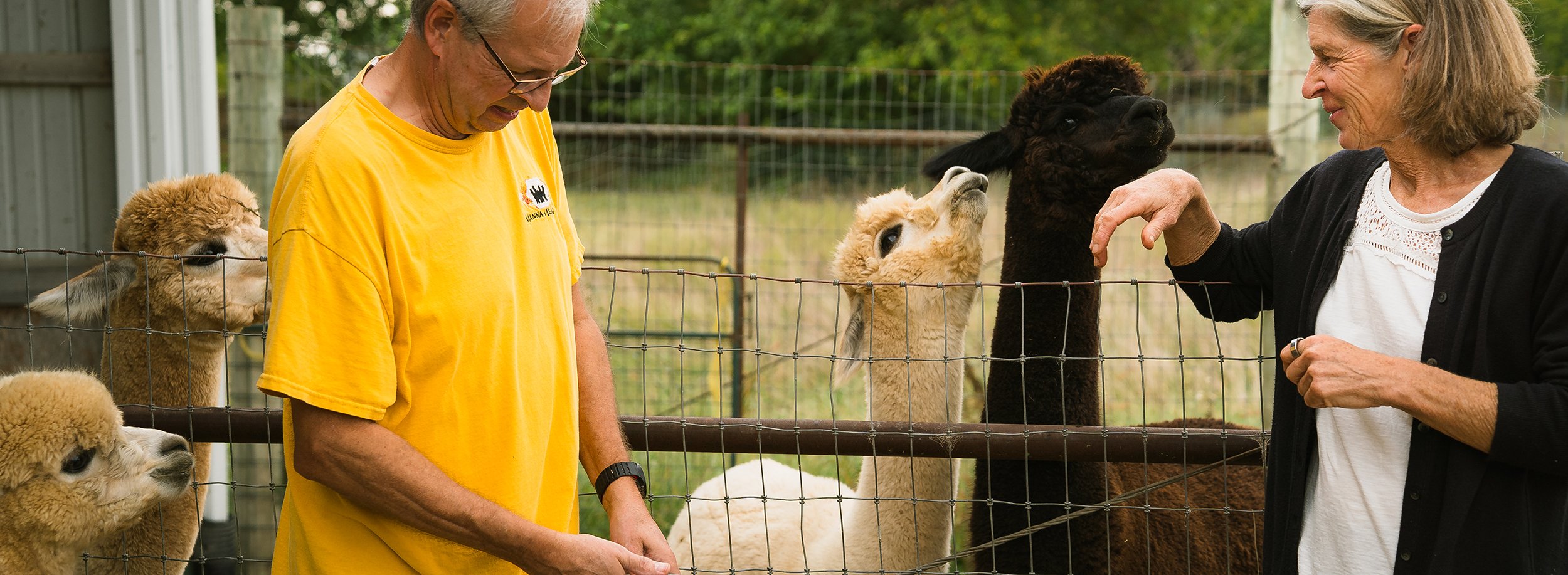
Pauline Verbeek as Senior Professor of Fiber: Recognizing a Relentless Pursuit of Understanding and Beauty
10.20.2025
Recently elevated to Senior Professor of Fiber, Pauline Verbeek channels her global experience and "need to know" scientific curiosity into challenging KCAI students to define their "vector of impact" while considering natural materials.
“...één, twee, drie, vier…”
Counting in Dutch sometimes earns Senior Professor of Fiber Pauline Verbeek a few giggles from students in the weaving room. It’s one of the four languages she knows fluently. English contains her professional lingo. German and French she learned along the way. Still, when it comes to patterns and calculations at the loom, her numbers always return to her mother tongue.

But her deep digital recall comes from an early life defined by constant movement and change. Born in Hong Kong, she has since lived on four continents and in six countries, attending fourteen schools. After college, she was in Germany when the Berlin Wall fell. Today, she lives on a Kansas farm, about an hour from campus.
She says that the longer you live somewhere, the more you assimilate. And after 30 years at the Kansas City Art Institute, including a long tenure as Chair of the Fiber Department, she has become an institutional staple. The school cemented this status at the start of the 2025-2026 year, naming her Senior Professor of Fiber.
Yet, even with her established local roots and professional advancement, her self-described Dutch traits still shape her reputation among students and colleagues. “I don’t want to say we’re suspicious,” she explains, “but we like to poke, you know? Ask questions.”
“I think that is why I love the scientific part of textiles. You never know what you'll find out. So my questioning and my poking is because I just want to know. I really just want to know, and not because I'm nosy, because I want to understand,” she says.
Weaving Origins
As an educator, Pauline resists showing too much of her own work in the classroom. “I don't want to produce clones,” she says. “I want them to explore what they’re interested in. You're not here to please me.”
“For me, teaching means not being in control of everything. And that’s a good thing,” she says.
This approach stems from personal experience: Pauline had to rebel against her parents' dream for their dexterous daughter to become a dentist. Without the benefit of the internet, she undertook her educational journey as a personal research project. Nearing college age, she traveled alone to Stuttgart, where she stayed in a youth hostel for a week. Every day, she visited the embassy to research and apply to American art schools, eventually deciding on the Maryland Institute College of Art.
“I tricked them into thinking that I was going to do interior design. Because that sounded like a profession, you know? And I spent one day in the interior design department and I was like ‘No, I’m switching to fine art,’” she says, chuckling at how those distinctions would blur over time.
In her final semester, she learned to weave, and something clicked. It became clear that this was what she wanted to do. But the path wasn’t straightforward. After graduating, she returned to Europe when her student visa expired, only to realize she no longer had an art community and struggled to find her place. Jobless, she received astute advice from a German acquaintance: “You have a degree from an American institution. The Americans are all over the place. Apply with the service.”
“So I applied,” she recalls. “And they bowed down to me because they were like, ‘Oh my God, somebody with a BFA!’” For the next 10 years, she worked in Karlsruhe, Germany, as an Arts & Crafts Director, creating programming for servicemembers and their families. Weaving, however, remained on her mind. After a decade in that role, she decided to pursue her graduate degree at the University of Kansas.
Her research and practice have continued since and can be divided into two distinct bodies of work: her serious artwork and her more playful explorations.

Just outside of Bonner Springs, Kansas, Brian Heimes tends his herd at Manna Meadows Alpacas. While they’ve cared for as many as 55 alpacas in the past, his recent focus has shifted to the fiber itself, specifically, weaving and knitting. This sharpened dedication has led him to form a valuable connection with KCAI.
During a recent visit to the farm, Heimes shared that he first learned of Pauline through a book by weaver Alice Schlein. In the back, he discovered her name listed as a specialist in Jacquard looms, unaware that she happened to live less than ten minutes away. They would connect years later through a student.
Brian, who has an innate mechanical skill but no formal training in art and design, handles the looms. His strong working relationship with Pauline allows her to focus on exploring new possibilities and techniques using her design expertise. "For me, it’s invaluable to find people who have either an innate or a developed ability to design and work with the materials,” Heimes explains.
“And Pauline is not just a good person to know,” he says. “She’s also an all around good person.”
Textile Precision
Pauline's work at the farm is a clear step away from what she calls her "serious artwork," which is woven on a computer-controlled Jacquard loom. This process gives her ultimate control, allowing her to manipulate every single thread to translate complex images directly into woven form. “My loom has almost 1,500 individual threads,” she explains. “When you weave, you’re essentially creating a checkerboard, like a pixel grid. Think of the digital binary system of on and off: if you have black threads and weave with white, it’s always either over or under.”
The images are translated through her chosen materials and their textures. A near-purist, she works almost exclusively in black and white, letting the weave itself create the grayscale. She avoids color, not wanting it to interfere with what she’s communicating, noting that people tend to respond to color first. Nor does she want the result to be mistaken for a photograph. Her work instead explores the interplay between image and material.
“So the giant swirls you’ve seen, that’s how I receive my material from Japan. It comes in these huge bundles. I scan those bundles in certain formations, and then I weave with the same material. So the image, you know, is informed by the very material it’s woven with,” she says.
“With this technology, you can change the scale. So does it look like a hay bale? Does it look like a wave? What does it look like? People don’t know what it is, but it feels familiar. It’s not like walking past a piece of art and saying, ‘Oh, I get that.’”
"My questioning and my poking is because I just want to know. I really just want to know, and not because I'm nosy, because I want to understand."
Material Discovery
Her second body of work, where she experiences true pleasure in playing and feels the excitement of coming up with “new recipes,” is her yarn exploration. “I love yarn in every form. Wool is my fiber of choice, but I teach a lot about the chemistry and properties of natural materials. I’ve developed my own yarn. I’ve thought a lot about its structure.”
“Somebody once said I should be called a yarnologist,” she says.
As a weaver, she focuses on finding the perfect balance among several elements including the yarn’s capability to transform, the structure of the work (meaning the precise way yarn is interlaced), and the effects of the final finishing methods. Together, these elements create something that the loom alone cannot achieve.
“That requires a lot of knowledge, and to me, that is an exciting area. This is where functional fabrics come in—fabrics for interiors. There’s an application, but it can also be artwork,” she says, acknowledging how her parents’ hopes for her to study interior design eventually nested in an unanticipated way.

Creative Growth
One of the joys of weaving, Pauline says, is watching a piece grow over time. As the yarn transforms, the process itself stimulates her, sparking ideas for entirely new projects.
This creative drive extends far beyond her studio. For example, she has personally built five houses, tackling everything from architecture, design, and planning to electrical, insulation, finish plumbing, tiling, and painting. "I do everything," she states, offering a precise, humble disclaimer: "Well, not the concrete, framing, or sheet rock, I suppose."
“I just want to make beautiful things. You know, and the world is ugly enough,” she says.
Another obvious place for growth is her garden. After 40 years of experience, she’s serious, operating a compost research business. This is no casual hobby. She has a giant tractor and a Turner. She makes 100 foot long windrows. “Like, it's serious business. I have a 30 by 72 foot high tunnel. I'm growing plants at scale. I’m stewarding 90 acres of land, regenerating the soil, and restoring the woodlands
This passion for conscious production is rooted in her awareness that the textile industry is one of the most polluting industries in the world. It’s one of the reasons that she has stepped away from the gallery scene. In the same way she can grow vegetables or fruit to nourish people, she is now cultivating natural dye plants.
“You know, there are people who are willing to spend a little more if they know things were done right. My fiber of choice is wool, and I know a lot of people who process it. I take students there because I want them to understand the raw material,” she says, adding her hope that together they will create a new, smaller-scale local textile economy that doesn’t necessarily replace the existing supply chain but adds to it. She calls this their “vector of impact.”
Unflinching Honestly
Pauline laughs when recalling feedback from some Fiber alumni. “They let the cat out of the sack and say they were scared shitless of me. At least at first because I was demanding and didn’t let anyone get away with anything. But that’s my job.” Like in the garden, she says, growth happens through change, and change only occurs when something is different.
Her new title as Senior Professor of Fiber affirms her enduring respect and leadership at the Kansas City Art Institute, a position Pauline earned by never shying away from rocking the boat.
“My desire to understand is rooted in the search for truth,” she says. “And truth is something you reach only through intense and serious debate. I want students to question everything, be curious, and not swallow something just because it’s presented or taught as fact.”
“And it's important that we model the behavior we would like to see in our students,” she continues. “We should develop the courage to stand for what you believe in. Even if that is not well received, I will know I tried.”